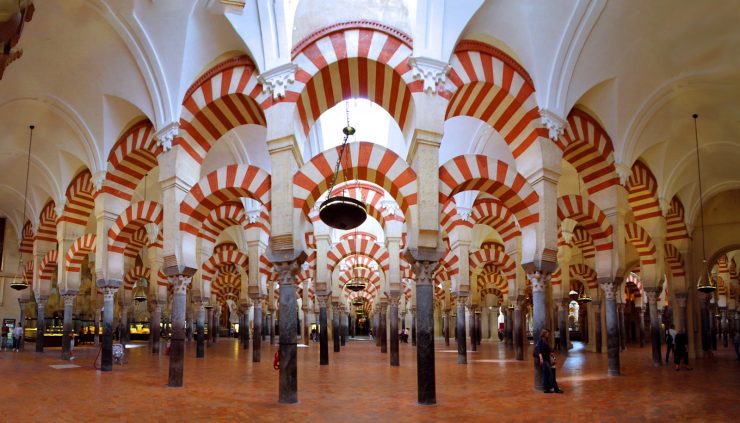 Do you want to read in English? Click here
Do you want to read in English? Click here
 Caracterización histórica del legado cultural de Córdoba
Caracterización histórica del legado cultural de Córdoba
Uno de los aspectos más significativos del patrimonio histórico en nuestra ciudad tiene una clara condición de capitalidad. La urbs es de trazado romano, de ahí emana esa imagen de Córdoba romana.
El elemento clave sobre el cual se articula toda esta consecución de pueblos es el puente, en torno al cual surge la ciudad; elemento, por tanto, articulador.
Podemos ver claros procesos de humanización continua y de especial relevancia desde antiguo, denotadores de un legado patrimonial muy rico y diverso: sobre la ciudad romana y actuando esta como base, se va configurando la Córdoba musulmana, judía, cristiano-visigoda…
Las expresiones tanto materiales como inmateriales de nuestro rico patrimonio se despliegan en varios ejes, que más que una visión de diversidad cultural, genera una realidad patrimonial que nos muestra un solapamiento de culturas a lo largo de la historia de nuestra ciudad:
-Córdoba romana: ciudad fundada alrededor del año 169 a.C. Los elementos característicos de esta es la urbs o trazado romano, que actúa como base de la actual ciudad.
-Córdoba musulmana: su inicio data del año 711. La Medina es el elemento principal que experimenta un proceso de solapamiento sobre la estructura de la urbs romana. La expansión extramuros que se sucede en la ciudad durante este periodo da lugar a los tan característicos arrabales.
Hay un claro factor de centralidad política en torno a los emiratos y el califato. La Medina, por tanto, es una consecuencia directa del califato: una nueva realidad, una ciudad fugaz. La mejor representación de esto la encontramos tanto en los Baños Califales como en el conjunto arqueológico de Medina Azahara, una expresión del poder del califato, a unos 6 kilómetros al oeste de la ciudad.
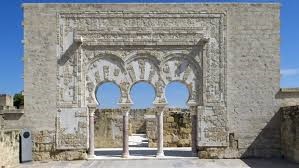
-Córdoba cristiana: surge a partir del año 1.236 en adelante; se acontece un desdoblamiento de la ciudad anteriormente consolidada en dos áreas bien reconocibles (Medina/Villa y Axerquía)
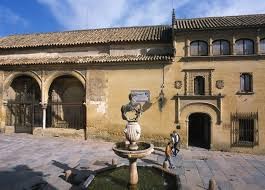
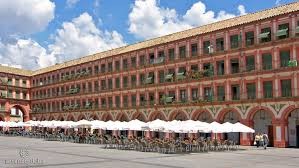
La consolidación de esta nueva estructura tiene lugar al este de la medina musulmana, con arrabales (pequeños barrios de carácter disperso) y huertas que articulan una nueva estructura de barrios, localizados en torno a las parroquias y las Iglesias Fernandinas. Estas parroquias de la ciudad cristiana amplían el espacio y dan lugar a la estructura actualmente reconocible en el centro histórico, teniendo lugar así un proceso de duplicado en la ciudad.
Los principales elementos representativos de este fenómeno acontecido son el Palacio de Viana o el Palacio de Orive, así como las plazas singulares como son la Plaza del Potro o la Plaza de la Corredera, además de espacios populares, como es el caso del patio, constituido como un espacio privado de sociabilidad, que representaba la forma de vida local, clara herencia de la estructura de la casa hispano-romana e hispano-musulmana. Otro elemento a destacar durante esta época es la existencia de una Catedral dentro de la propia Mezquita (construida esta a su vez sobre la basílica de San Vicente), resquicio significativo tanto patrimonial como social.

-Córdoba judía: aunque la Córdoba judía está presente hasta el año 1.492, la presencia de esta cultura en la ciudad se empieza a fundar durante la época romana. Este pueblo siempre ha ostentado un carácter marginal, debido al componente de segregación, muestra de ello es el barrio de la Judería, espacio aglutinador dentro de la propia ciudad romana, musulmana y cristiana. La Judería constituye un elemento zonal que está sufriendo un fuerte impacto visual y funcional a día de hoy debido al desplazamiento del uso residencial por la dinamización turística de carácter masificado.

2. Los reconocimientos del valor patrimonial en Córdoba
Dentro del patrimonio histórico español, son declarados como bien de interés cultural (BIC) el centro histórico de Córdoba además de múltiples bienes singulares.
Por otro lado, respecto a la declaración de nuestro patrimonio mundial de mano de la UNESCO, encontramos 4 reconocimientos distintos dentro del municipio de Córdoba, único que cuenta con este número de declaraciones. Estos reconocimientos se corresponden con los siguientes elementos:
– Mezquita-Catedral (1984).
– Parte del centro histórico (sector circundante a la Mezquita-Catedral, en 1994, una década después), que este año celebra su 25 aniversario con el motivo del reconocimiento otorgado.
– La fiesta de los Patios (2012).
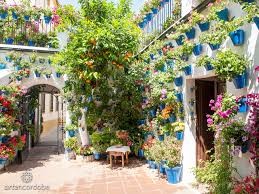
– Conjunto arqueológico de Medina Azahara (2018).
3. Estrategias y/o propuestas para la inclusión de las comunidades locales en el ámbito turístico: retos y recomendaciones.
-Los Patios: resultaría importante destacar el caso de la fiesta de los Patios en este aspecto por la declaración por parte de la UNESCO como Patrimonio de la Humanidad, que como ya hemos comentado, solo atiende a la consideración de fiesta, olvidándose así de los aspectos más importantes de esta realiadad: la forma de vida, la tradición, el folklore, vida comunitaria entorno a un espacio privado que era conservado por los propios vecinos, espacio de recreación donde se compartía el tiempo, la vida…
Se está desencadenando, por tanto, un fenómeno muy poco conveniente en nuestra ciudad, como es la masificación turística en la temporada alta durante el mes de Mayo, la propia desvirtualización de la cultura, el impacto paisajístico que esto supone, y la pérdida de valores junto con la conservación de estos espacios. Además, los concursos que se organizan no acaban de ayudar a mantener viva esta tradición, ya que el coste para los pocos vecinos que aun llevan a cabo esta labor es superior al beneficio que reciben, por tanto, se están viendo privados de su espacio privado con altos costes, ya que no solo nos referimos al coste económico.
Sin embargo, hemos de decir que esta fiesta que nace gracias a la colaboración público-privada de nuestra ciudad, permite la proyección pública y turística de esta fiesta y por otra parte, hace que los establecimientos turísticos (como son los hoteles y restaurantes, especialmente) obtengan grandes beneficios económicos.

-Planificación turística: la estrategia turística se ha articulado de manera teórica en la planificación a través de la sucesión de 4 planes diferentes, los cuales han otorgado un papel muy escaso a la participación de la comunidad local en esta dimensión.
Tabla: Planificación turística del destino Córdoba (2001-2019)
| Plan de Excelencia Turística | 2001-2009 |
| Plan Estratégico de Turismo | 2009-2015 |
| Plan Turístico de Córdoba | 2014-2016 |
| Plan Estratégico de Turismo | 2015-2019 |
Fuente: Elaboración propia a partir de «La Planificación del destino Córdoba: análisis crítico del Plan Estratégico de Turismo 2015-2019», J.C, González.
La planificación propuesta en el Plan Especial de Protección del Casco Histórico del 2003, que ostenta una efectividad dispar (PEPCH a partir de ahora), tiene un carácter de incidencia física o urbanística, atendiendo así al paisaje urbano del municipio cordobés, pero a su vez olvidando de esta manera la dimensión turística, la cual es tan relevante en una ciudad como la nuestra. Por tanto, vemos como un plan de gestión turística, y especialmente referido a una participación local para las zonas así declaradas por la UNESCO, no ha sido aprobado como tal. Sin embargo y teniendo en cuenta el valor intrínseco de nuestro centro histórico, la propia institución de la UNESCO ha elaborado 2 informes sobre este aspecto.
Hemos de añadir aquí que, ninguna de medida de protección para el entorno del centro histórico declarado como Patrimonio de la Humanidad ha sido adoptada, es decir, la “zona de amortiguamiento” no ha sido ni siquiera delimitada. Los límites del centro histórico son difusos, tanto es así que en ocasiones ni los propios cordobeses son capaces de reconocerlos de manera clara. Vemos por lo tanto, un denotador desconocimiento y escasa valoración social y turística del espacio urbano declarado.
Es necesario además, atender a la importancia de estos hitos zonales, es lugar de sobre masificar el carácter zonal de los diversos monumentos de la ciudad, para mantener la conservación de todos ellos y dar a conocer estas áreas que parecen ajenas al turista, e incluso a la población local.
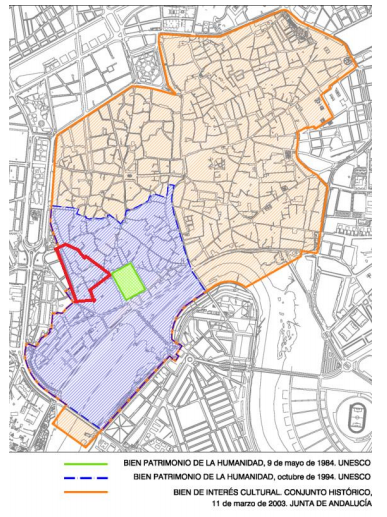
Ilustración: Delimitación del Conjunto Histórico de Córdoba y de la zona Patrimonio de la Humanidad radicada en su interior. – Fuente: Pagina Web de la Gerencia de Urbanismo de Córdoba
4. Iniciativas turísticas específicas: medidas para la habitabilidad.
Especialmente necesarias atendiendo a la problemática de la población local en el espacio urbano de mayor valor patrimonial (Centro histórico-zona Patrimonio de la Humanidad). Podría implementarse en la zona del Centro Histórico un plan similar al establecido mediante el Área de Rehabilitación concentrada de la Axerquía Norte (desdoblamiento de la ciudad del que hablabamos).
Ayudas para la rehabilitación de inmuebles en situación de abandono sería especialmente conveniente, tanto para mantener la conservación del patrimonio y las funciones locales, como para mantener, consecuentemente, el uso turístico en esta parte de la ciudad.
-Convivencia de usos.
-Señalización, normativa más estricta sobre todo con la cartelería.
-Descontaminación visual.
-Recuperación de oficios.

Ilustración: La Judería de Córdoba, en pleno corazón del Centro Histórico, con cartelería incumpliendo la normativa, con productos estandarizados y masificación turística – Fuente: Elaboración propia
La proliferación reciente de empresas de servicios turístico está potenciando la participación local-privada en nuestra ciudad. Especialmente, las iniciativas de turismo temático de base patrimonial, cuentan con esta participación de agentes locales (ArtenCórdoba, Córdoba by Seqway, Córdobaviva, Córdoba Misteriosa, Cordobafilia…entre otras). Estas iniciativas están revalorizando la dimensión turística, diversificando el modelo.
Debemos de tener claro que el turismo es el camino, nunca el último fin, por lo que no debemos monopolizar el sector porque podría ser el principio de un problema estructural en este sentido. Convivencia de usos y diversificación es la clave para mantener vivo nuestro territorio, nuestro patrimonio, nuestra población local y por supuesto, nuestro modelo turístico.
 The historic nature of Córdoba’s cultural legacy
The historic nature of Córdoba’s cultural legacy
One of the most significant aspects of Córdoba’s historical heritage is its clear status as a capital. The city is traced out along Roman lines, hence the image that has emerged of Roman Córdoba.
The key element, drawing a succession of peoples to settle, has been the bridge, the construction around which the city emerged and therefore its focal point.
It is possible to see clear processes of continuous and particularly important human settlement from antiquity, signifiers of a highly rich and diverse cultural legacy: on top of the Roman city, which provided the foundation, Muslim, Jewish and Christian-Visigothic Córdoba were all constructed.
Both the tangible and non-tangible manifestations of our rich heritage express themselves in a number of different strands, which rather than a vision of cultural diversity, produce a heritage picture that reveals an overlapping of cultures over the course of the city’s history:
-Roman Córdoba: city founded around the year 169 BC. The characteristic element of this is the urbs, or Roman layout, which provides the basis for the current city.
-Muslim Córdoba: its beginnings date back to the year 711. The medina is the principal element, which underwent a process of overlapping the Roman urbs. The extramural expansion that took place in the city during this period gave rise to the highly characteristic arrabales, or peripheral districts.
There was a clear element of political centrality surrounding the emirates and the caliphate. The medina was therefore a direct consequence of the caliphate: a new reality, a fleeting city. The best demonstration of this is to be found in the Arab Baths, as well as at the archaeological site of Medina Azahara, an expression of the caliphate’s power located some six kilometres to the east of the city.

-Christian Córdoba: emerged from 1236 onwards; a division of the city occured, formerly consolidated into two well-recognised areas (Medina/Villa and Axerquía).

Illustration: La Plaza Corredera (Axequía) Courtesy: Arte en Córdoba The consolidation of this new structure took place to the east of the Muslim medina, with arrabales (small scattered districts) and orchards providing a new structure of neighbourhoods, centred around the parishes and the Fernandine churches. These parishes of the Christian city enlarged the surface area and produced the currently recognisable structure in the historic centre, thereby giving rise to a process of duplication in the city.
The main elements demonstrating this phenomenon are the Palacio de Viana and the Palacio de Orive, as well as such singular squares as the Plaza del Potro and the Plaza de la Corredera; other examples include communal spaces such as the patios, constituted as a private space for socialising, which represented the local way of life and is clearly inherited from the structure of the Hispano-Roman or the Hispano-Muslim house. Another notable element from this period is the existence of the cathedral within the mosque (the latter built in turn on the remains of the San Vicente basilica), a significant vestige in both heritage and social terms.

-Jewish Córdoba: although the Jewish community in Córdoba maintained a presence up until 1492, the origins of Judaism in the city can be traced back to the Roman era. This community was always characterised by its marginal nature, owing to the practice of segregation; exemplifying this is the Judería, or Jewish quarter, a cohesive area within the Roman, Muslim and Christian city. The Judería constitutes a geographical area that is currently suffering major visual and functional impacts, with residents being displaced by the rise of mass-tourism.

Courtesy: the author2. Recognitions of the value of Córdoba’s heritage
Among official Spanish heritage sites, Córdoba’s historic centre has been classified as an asset of cultural interest (BIC), as have several other individual locations.
Meanwhile, in terms of UNESCO’s system of world heritage sites, the city of Córdoba has been awarded four distinct recognitions, the only city that can boast so many awards. The honours were conferred upon the following elements: – The Mezquita-Cathedral (1984). – Part of the historic centre (the area surrounding the Mezquita-Cathedral, awarded a decade later in 1994), with this year marking the 25th anniversary of the award being bestowed. – The Patios festival (2012). Illustration: Córdoba’s patios Courtesy: Arte en Córdoba – The archaeological site of Medina Azahara (2018).
- Strategies and proposals for the inclusion of local communities in tourism: challenges and recommendations.
-The Patios: it is important to highlight the case of the Patios festival in this regard and UNESCO’s decision to classify it as intangible cultural heritage, which, as has already been mentioned, focuses exclusively on the festival dimension, thereby overlooking more important aspects of the patios: the way of life, the tradition, the folklore, the communal life revolving around a private space that was maintained by its own residents, a recreational space for sharing one’s time and life, and so on.
What has consequently emerged is a phenomenon that is not at all desirable in our city, namely mass tourism in the high season of May, the devaluation of the culture, the impact on the cityscape that this represents and the loss of values as well as the conservation of these spaces. Moreover, the competitions that are run are not sufficient to help to keep this tradition alive, because the cost for the few residents who are still prepared to put in the work exceeds the recompense they receive; they are therefore being deprived of their private space at a high price, given that the costs are not only economic ones.
On the other hand it should be said that this festival, which grew out of a public-private partnership in the city, has enabled the patios’ profile to be raised among the general public and tourists alike, and it also ensures that businesses reliant on tourism (especially hotels and restaurants) reap significant economic rewards.

-Tourist planning: the city’s tourism strategy has unfolded theoretically in a series of four successive plans, each of which have awarded a meagre role to the participation of the local community to this aspect of the city’s life.
Table: Tourism planning in Córdoba (2001-2019)
| Excellence in Tourism Plan | 2001-2009 |
| Strategic Tourism Plan | 2009-2015 |
| Córdoba Tourism Plan | 2014-2016 |
| Strategic Tourism Plan | 2015-2019 |
Source: Author’s own compilation based on La Planificación del destino Córdoba: análisis crítico del Plan Estratégico de Turismo 2015-2019, J.C. González.
The planning set out in the 2003 Special Protection Plan for the Old Town, which was rather uneven in its effectiveness, was notable for its emphasis on the physical urban scene, focusing primarily on Córdoba’s cityscape, and thus overlooking the tourist dimension, something that is so important in a city like Córdoba. It was evident therefore that a tourism management plan, especially in terms of local participation in the areas recognised by UNESCO, had not been approved as such. Bearing in mind the intrinsic value of Córdoba’s historic centre however, UNESCO itself has drawn up two reports on this subject.
It needs to be added here that no protection measures have been taken for the area around the historic centre designated as a World Heritage Site, in other words the “buffer zone” has not even been delineated. The boundaries of the historic centre are unclear, so much so that sometimes even Córdoba residents are unable to identify them with certainty. Consequently, there is a notable level of ignorance and little social or tourist value placed on the designated urban space.
It is also necessary to emphasise the importance of these zonal landmarks, rather than over-concentrating visits to the zones around the city’s various monuments, to safeguard the conservation of all of them and to raise awareness of the areas that seem to be neglected by tourists, and even the local population.

-Specific tourist initiatives: measures to improve habitability.
These are especially necessary in light of the problems facing the local population in the urban setting with the highest heritage value (Historic Centre-World Heritage Site). A plan could be implemented in the Historic Centre similar to the one established with the Rehabilitation Area centred on the Axerquía Norte district (the division of the city referred to above).
Subsidies for rehabilitating buildings that have been abandoned would be especially desirable, both for the purposes of heritage conservation and for preserving local facilities, as well as maintaining, as a consequence, the tourist visits to this part of the city.
-Coexistence of uses.
-Signage, stricter regulations especially for signboards.
-Visual clean-up.
-Restoration of trades.

Courtesy: the author
The recent growth of companies offering tourist services is strengthening local-private participation in Córdoba. Heritage-based themed tourism initiatives in particular exemplify this type of participation by local actors (ArtenCórdoba, Córdoba by Segway, Córdobaviva, Córdoba Misteriosa and Cordobafilia, among others). Such initiatives are extracting new value from tourism, diversifying the business model.
We need to be clear that tourism provides a pathway, not the ultimate goal; this means that we should not seek to monopolise the sector, because this could lead to the start of a structural problem. Coexistence of uses and diversification are the key to sustaining our territory, our heritage, our local population and, of course, our tourism model.

